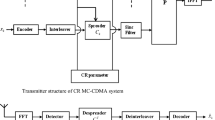Abstract
In this contribution, the performance of double space time transmit diversity (DSTTD) based multiple-input and multiple-output system with spatial diversity is investigated for cognitive radio network (CRN) based code-division-multiple-access (CDMA) system. CRN is realized in order to invoke available idle spectrum for reliable communication between base station and mobile station. DSTTD is constructed using two space- time processing unit. DSTTD is proven to provide high throughput .The user-specific spreading code is generated using sub-band frequency of CRN. Time-Frequency domain signature sequence is exploited to distinguish secondary users. The performance of CRN based DSTTD-CDMA scheme is analyzed using coded system. At each MS, iterative type of decoder is implemented to estimate secondary users’ information. The performance is analyzed for coded CRN based DSTTD-CDMA system for channel model with Stanford University Interim along with long-term evolution specifications. It is observed through simulation results that coded CR DSTTD-CDMA system establish proficient communication for secondary users while offering higher throughput and higher spectral efficiency and better performance in the context of bit-error-rate with fewer value of signal-to-noise ratio. Further, it is discerned that decoding algorithm obviate adjacent-channel interference along with secondary multi-user interference and CRN based CDMA system in conjunction DSTTD offers solution for high data rate application.




Similar content being viewed by others
References
Foschini, G.J.: Layered space-time architecture for wireless communications in a fading environment when using multi-element antennas. Bell Labs Tech. J. 1(2), 41–59 (1996)
Alamouti, S.M.: A simple transmitter diversity scheme for wireless communications. IEEE J. Sel. Areas Commun. 16(8), 1451–1458 (1998)
Tarokh, V., Jafarkhani, H., Calderbank, A.R.: Space-time block codes from orthogonal designs. IEEE Trans. Inf. Theory 45(5), 1456–1467 (1999)
Abdaoui, A., Ikki, S.S., Ahmed, M.H.: On the performance analysis of a MIMO-relaying scheme with space–time block codes. IEEE Trans. Veh. Technol. 59(7), 3604–3609 (2010)
Femenias, G.: BER performance of linear STBC from orthogonal designs over MIMO correlated Nakagami-\(m\) fading channels. IEEE Trans. Veh. Technol. 53(2), 307–17 (2004)
Han, C., Doufexi, A., Armour, S., Ng, K.H., McGeehan, J.: Adaptive MIMO OFDMA for future generation cellular systems in a realistic outdoor environment. In: 63rd IEEE Vehicular Technology Conference (VTC 2006-Spring) Australia, pp. 142–146, 7–10 (2006)
Jingxian, W., Zhang, Y.E., Gumaste, A., Xiao, C.: Error performance of Double space time transmit diversity system. IEEE Trans. Wirel. Commun. 6(9), 3191–3196 (2007)
Lee, Y., Shieh, H.W.: A simple layered space-time block nulling technique for DSTTD systems. IEEE Commun. Lett. 15(12), 1323–1325 (2011)
Vishvaksenan, K.S., Kalaiarasan, R.: Multi-cell DSTTD-IDMA system using transmitter pre-processing. In: International conference on Wireless Communications, Signal Processing and Networking (WISPNET), pp. 1732–1736 (2016)
Vasanth Raj, P.T., Vishvaksenan, K.S.: System analysis of DSTTD-CDMA system with polarization diversity for frequency-selective channel. J. Comput. Electr. Eng. https://doi.org/10.1016/j.compeleceng.2016.11.027 (2016)
Vishvaksenan, K.S., Seshasayanan, R., Subramanian, Sudharssun: Performance of Dual-Polarized DSTTD-IDMA system over correlated frequency selective channels. J. Comput. Electr. Eng. 40, 1296–1305 (2014)
Shahrokh, H., Mohamed, K.: A New structure for NC-MC-CDMA in Cognitive radio networks. In 9th International Symposium on Communication and Information Technologies, pp. 653–657 (2009)
Kondo, S., Milstein, L.B.: Performance of multicarrier DS CDMA systems. IEEE Trans. Commun. 44(2), 238–246 (1996)
Rammya, B., Vishvaksenan, K.S., Poobal, S.: Performance of spectrum sharing cognitive radio network based on MIMO MC-CDMA system for medical image transmission. J. Clust. Comput. https://doi.org/10.1007/s10586-017-1290-9 (2017)
Rajmohan, R., Vishvaksenan, K.S., Mira, M., Subramanian, S.: Performance of a turbo-coded downlink IDMA system using transmitter pre-processing. Comput. Electr. Eng. 53, 385–393 (2016)
Leela, S., Vishvaksenan, K.S.: Performance of adaptive MIMO switching for aognitive MC-CDMA system. J. Clust. Comput. https://doi.org/10.1007/s10586-017-1322-5 (2017)
Karthipan, R., Vishvaksenan, K.S., Kalidoss, R., Krishan, A.: Performance of turbo coded triply-polarized MIMO-CDMA system for downlink communication. Elsevier J. Comput. Electr. Eng. 56, 182–192 (2016)
Maucher, J., Furrer, J., Heise.: IEEE Std. 2007, IEEE Standard for WIMAX 802.16, Publisher, Hannover (2007)
3GPPP (TR 30.803), Evolved universal terrestrial radio access (E-UTRA); user equipment (UE) radio transmission and reception (Release 8), Technical specification, Sophia Antipolis, France (2007)
Mithra, K., Vishvaksenan, K.S.: Performance of coded STBC-IDMA system using polarization diversity for downlink transmission. J. Clust. Comput. 20(2), 1615–1623 (2017)
Author information
Authors and Affiliations
Corresponding author
Rights and permissions
About this article
Cite this article
Kumar, R.D., Vishvaksenan, K.S. & Mithra, K. Cognitive radio network based DSTTD-CDMA system. Cluster Comput 22 (Suppl 4), 8561–8567 (2019). https://doi.org/10.1007/s10586-018-1902-z
Received:
Revised:
Accepted:
Published:
Issue Date:
DOI: https://doi.org/10.1007/s10586-018-1902-z




